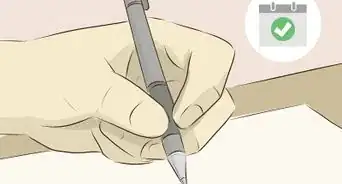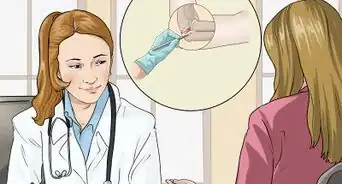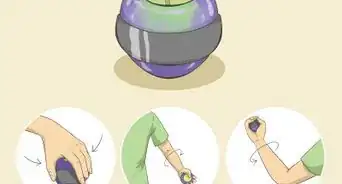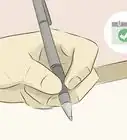X
wikiHow is a “wiki,” similar to Wikipedia, which means that many of our articles are co-written by multiple authors. To create this article, 14 people, some anonymous, worked to edit and improve it over time.
This article has been viewed 30,726 times.
Learn more...
Are you trying to pass your CNA clinical test, or a CNA providing help to someone with a weak arm? If this is you, this instruction set will guide you in helping someone with a weak arm get dressed, while promoting the patient's comfort, rights, and safety. This instruction set is based off of Prometric's checklist.
Steps
Part 1
Part 1 of 3:
Meeting the Patient
-
1Knock on the patient's door and wait for them to respond for you to come in. They usually will respond, but if there is no response, then let the nurse know.[1]
-
2Greet the patient by their name. Doing this is important because if the patient does not respond to their name, then you could be with the wrong patient.[2]Advertisement
-
3Introduce yourself. Tell the patient who you are, including your name. This is important because the patient would want to know who you are so they can feel safe.[3]
-
4Inform the patient of the plan. You have to tell the patient what you are doing and make sure they are comfortable with it. This is important because the patient may not want to be dressed, and you have to respect their rights.
-
5Read the patient's care plan. The patient care plan is important to read because it has all the basic needs and information about the patient. The patients care plan will inform you about which arm is weak and which arm is strong if it is not obvious.[4]
-
6Ask the patient what he/she wants to wear. Your patient may care about what they wear. It is important to promote their rights and let them choose what they want to wear.
-
7Get article of clothing the patient wants to wear. Go get their clothing from their closet to start dressing them. If taking the CNA clinical test, the shirt will always be a button up.
-
8Grab a barrier. A barrier will be used to be put on the table so when you place the patient's clothing on the table, the barrier will protect the clothes from getting dirty. A barrier could be a towel, or small flat sheet.
-
9Place the barrier on the table. Make sure it will be big enough for all the clothing to fit on top of it.
-
10Place the clothing on top of barrier. Make sure the clothing is fully on the barrier and not touching the table.
-
11Close the privacy curtain. When you are ready to dress the patient, it is important to make sure the patient is not exposed to anyone and is comfortable. You have to respect the privacy of patients.
-
12Wash your hands. It important to wash your hands for 20 seconds before touching the patient to prevent any spread of infections to the resident.
Advertisement
Part 2
Part 2 of 3:
Dressing the Patient
-
1Put the bed in position easiest to change them in. To make this process faster for you, place their bed position in a way that will be easier for you to change them. To move the bed, just use the bed control remote. While moving the bed tell the patient you are doing so, as the patient could become startled.
-
2Place the privacy blanket on the patient. A privacy blanket is put on top of the patient while taking off their clothes so their bodies will not be exposed.[5] This will make the patient feel comfortable and keep them warm.
-
3Unbutton the patient's shirt. While doing so, make sure the patient's body is not too exposed.
-
4Take off the patient's shirt starting with the strong arm. Start with the patients strong arm when taking off their clothes. It will decrease the pain for them, and make it much easier to take off the clothing.[6] This will also allow for the shirt to come off smoothly through the weak arm, without having them tug it off. While doing so, always make sure the patient is comfortable. The Prometric checklist says it is an automatic fail if you do not take off the shirt starting with the strong arm.
-
5Lift up the patient's back. To get the shirt off to the other side of the body, it is important to lift up the patient's back so the shirt can slide through to the other side without tugging, or pulling on it.
-
6Remove the shirt completely off from the weak arm. This will decrease the pain in the weak arm tremendously because removing the shirt would be effortless for the patient and the shirt will just slide off.
-
7Put on the sleeve of the new shirt starting on the patient's weak arm. Roll the sleeve up the patient's arm very gently, this will cause no pain for the patient. The Prometric checklist says it is an automatic fail if you do not start putting on the shirt with the patient's weak arm.
-
8Lift up patient's back. To get the shirt on to the other side of the body, it is important to lift up the patient's back so the shirt can slide through to the other side without tugging, or pulling on it.
-
9Put the other sleeve of the shirt on the patient's strong arm. Slide on the sleeve gently on the second arm.
-
10Button the shirt. Make sure you button up the shirt completely.
-
11Pull off patient's pants. Both legs are strong in this scenario. Simply just pull their pants down. Make sure that the privacy blanket is over their private areas so they are not exposed.
-
12Put new pants on the patient. When putting on new pants, place both feet in both openings of the pants.
-
13Slide pants up the patient. Slide them up in a gentle manner all the way up to their waist.
-
14Take off the patient's old socks. Simply remove both socks by sliding it down the foot gently. Start by pulling the sock off the patient's heel in an upward motion, causing it to slide off. Take each sock off one at a time.
-
15Put on the new socks. Put socks on by starting with the toes and pulling them up the ankle one foot at a time.[7] Put on each sock one at a time.
-
16Place the dirty clothes and the barrier into the hamper. The dirty clothes and the barrier should be put in the hamper to keep the room tidy.[8]
-
17Remove the privacy blanket. Since the patient is fully dressed, he/she does not need the privacy blanket anymore.
Advertisement
Part 3
Part 3 of 3:
Finishing Up With the Patient
-
1Make sure the patient is comfortable. When you are done dressing the patient, it is important to know if they are comfortable with how the clothing is on.
-
2Put the bed in the lowest position. To do as so, just use the bed control remote. When you are about to leave the patient, make sure the bed is in the lowest position because if the patient falls off the bed, it will cause less injury. Let the patient know you are moving the bed so they do not become startled.
-
3Place the call light in reach of the patient. The call light is what a patient uses to notify the nurse that they need help. A patient needs their call light by them at all times in case of any emergencies. Make sure it is within the patient's reach so that they can alert you whenever they are needed.
-
4Open the privacy curtain. It is important to open to privacy curtain when you are done with your procedure because if the patient falls and cannot call for help, people could quickly see the patient fall and call for help as soon as possible.
-
5Wash your hands. After the procedure, it is important to wash your hands for 20 seconds to keep your hands clean, not spread any germs, or infections to other patients or people you will be in contact with.
Advertisement
Things You'll Need
- Patient's desired clothing
- Privacy blanket
- Barrier
References
- ↑ https://cnaclassesnearme.com/cna-skill-dressing-a-resident/
- ↑ https://cnaclassesnearme.com/cna-skill-dressing-a-resident/
- ↑ https://cnaclassesnearme.com/cna-skill-dressing-a-resident/
- ↑ https://cnaclassesnearme.com/cna-skill-dressing-a-resident/
- ↑ https://cnaclassesnearme.com/cna-skill-dressing-a-resident/
- ↑ https://youtu.be/VScDoIQE25Y?t=149
- ↑ https://youtu.be/VScDoIQE25Y?t=510
- ↑ https://youtu.be/VScDoIQE25Y?t=170
- https://www.cdc.gov/features/handwashing/
About This Article
Advertisement
.webp)
.webp)
.webp)
.webp)
.webp)
.webp)
.webp)
-1.webp)
.webp)
.webp)
.webp)
.webp)
.webp)
.webp)
.webp)
.webp)
.webp)

.webp)
.webp)
.webp)
.webp)
.webp)
.webp)
.webp)
-1.webp)
.webp)
.webp)
-2.webp)



-Step-15-Version-3.webp)



















-Step-15-Version-3.webp)



































Medical Disclaimer
The content of this article is not intended to be a substitute for professional medical advice, examination, diagnosis, or treatment. You should always contact your doctor or other qualified healthcare professional before starting, changing, or stopping any kind of health treatment.
Read More...